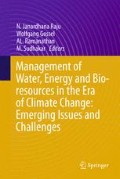Abstract
The global climate system is a consequence of and a link between the atmosphere, oceans, ice sheets (cryosphere), living organisms (biosphere), and soils, sediments and rocks (geosphere). The role of glaciers as sensitive climatic indicators and natural buffers of hydrological cycle is well established. In this era of much talked about climate change and global warming, glaciers have been correctly recognized as a thermometer and a crucial freshwater resource. Glaciers release meltwater during summers and early autumn, and, therefore, act as a water resource downstream by recharging river fed aquifer and influencing runoff (Bolch et al., 2012).
Access this chapter
Tax calculation will be finalised at checkout
Purchases are for personal use only
References
Ageta, Y. and Pokhral, A.P. (1999). Characteristics of mass balance components of summer accumulation type glacier in the Nepal Himalaya. Seppyo, 45: 81-105.
Berthier, E., Arnaud, Y., Kumar, R., Ahmad, S., Wagnon, P. and Chevallier, P. (2007). Remote sensing estimates of glacier mass balances in the Himachal Pradesh (Western Himalaya, India). Remote Sens. Environ., 108: 327-338.
Bhambri, R., Bolch, T., Chaujar, R.K. and Kulshreshtha, S.C. (2011). Glacier changes in the Garhwal Himalaya, India, from 1968 to 2006 based on remote sensing. J. Glaciol., 57(203): 543-556.
Bhutiyani, M.R., Kale, V.S. and Pawar, N.J. (2007). Long-term trends in maximum, minimum and mean annual air temperatures across the northwestern Himalaya during the twentieth century. Climatic Change, 85(1–2): 159-177.
Bishop, M.P., Kargel, J.S., Kieffer, H.H., MacKinnon, D.J., Raupand, B.H. and Shroder, J.F. Jr. (2000). Remote Sensing science and technology for studying glacier processes in high Asia. Ann.Glaciol., 31: 164-170.
Bolch, T., Kulkarni, A.V., Kääb, A., Huggel, C., Paul, F., Cogley, J.G., Frey, H., Kargel, J.S., Fujita, K., Scheel, M., Bajracharya, S. and Stoffel, M. (2012). The State and Fate of Himalayan Glaciers. Science, 336: 310-314.
Collins, D.N. and Hasnain, S.I. (1995). Runoff and sediment transport from glacierized basins at the Himalayan scale. International Association of Hydrological Sciences Publication 226 Symposium at Boulder 1995.
Dash, S.K., Jenamani, R.K., Kalsi, S.R. and Panda, S.K. (2007). Some evidence of climate change in twentieth-century India. Climatic Change, 85(3–4): 299-321.
Dimri, A.P. and Ganju, A. (2007). Wintertime Seasonal Scale Simulation over Western Himalaya Using RegCM3. Pure Appl. Geophys., 164: 1733-1746. DOI 10.1007/s00024-007-0239-y
Dobhal, D.P., Kumar, S. and Mundepi, A.K. (1995). Morphology and glacier dynamics studies in monsoon–arid transition zone: An example from Chhota Shigri glacier, Himachal Himalaya, India. Current Sci., 68(9): 936-944.
Dutta, Shruti, Ramanathan, AL. and Linda Anurag (2012). Shrinking Glaciers in the Beas Basin observed through Remote Sensing techniques, 1972–2006, Himachal Pradesh, India. J. Earth Syst. Sci., 121(5): 1105-1112.
Giles, H. Brown (2002). Glacier meltwater hydrochemistry. Applied Geochemistry, 17: 855-883.
Immerzeel, W.W, van Beeke, L.P.H. and Bierkens, M.F.P. (2010). Climate change will affect the Asian water towers. Science, 328: 1382-1385.
Kaul, M.K. (1999). Inventory of Himalayan Glaciers. Geol. Surv. India, Spl. Pub. 34.
Kulkarni, A.V., Bahuguna, I.M., Rathore, B.P., Singh, S.K., Randhawa, S.S., Sood, R.K. and Dhar, S. (2007). Glacial retreat in Himalaya using Indian remote sensing satellite data. Curr. Sci., 92(1): 69-74.
Paterson, W.S.B. (1994). The physics of glaciers. Third edition. Oxford, etc., Elsevier.
Shekhar, M.S., Chand, H., Kumar, S., Srinivasan, K. and Ganju, A. (2010). Climate-change studies in the western Himalaya. Ann. Glaciol., 51(54): 105-112.
Singh, Pratap and Jain, S.K. (2002). Snow and glacier melt in the Satluj River at Bhakra Dam in the western Himalayan region. Hydrological Sciences, 47(1): February 93.
Singh, Pratap, Haritashya, Umesh K., Kumar, Naresh and Singh, Yatveer (2006). Hydrological characteristics of the Gangotri Glacier, central Himalayas, India. Journal of Hydrology, 327: 55-67.
Singh, Virendra Bahadur, Ramanathan, AL., Jose, Pottakkal George, Linda, Anurag and Sharma, Parmanand (2013). Temporal Variation in the Major Ion Chemistry of Chhota Shigri Glacier Meltwater, Lahaul–Spiti Valley, Himachal Pradesh, India. Natl. Acad. Sci. Lett. ISSN 0250-541X. DOI 10.1007/s40009-013-0135-1.
Singh, Pratap, Ramasastri, K.S., Kumar, Naresh and Arora, Manohar (2000). Correlations between discharge and meteorological parameters and runoff forecasting from a highly glacierized Himalayan basin. Hydrological Sciences, 45(5): 637.
Vincent, C., Ramanathan, AL., Wagnon, P., Dobhal, D.P., Linda, A., Berthier, E., Sharma, P., Arnaud, Y., Azam, M.F., Jose, P.G. and Gardelle, J. (2013). Balanced conditions or slight mass gain of glaciers in the Lahaul and Spiti region (northern India, Himalaya) during the nineties preceded recent mass loss. The Cryosphere, 7: 569-582.
Wagnon, P., Linda, A., Arnaud, Y., Kumar, R., Sharma, P., Vincent, C., Pottakkal, J.G., Berthier, E., Ramanathan, AL., Hasnain, S.I. and Chevallier, P. (2007). Four years of mass balance on Chhota Shigri Glacier, Himachal Pradesh, India. A New Benchmark Glacier in the Western Himalaya. J. Glaciol., 53(183): 603-611.
Yadav, R.R., Park, W.K., Singh, J. and Dubey, B. (2004). Do the western Himalayas defy global warming? Geophysical Research Letters, 31(17). doi: 10.1029/2004GL020201.
Author information
Authors and Affiliations
Corresponding author
Editor information
Editors and Affiliations
Rights and permissions
Copyright information
© 2015 Capital Publishing Company
About this chapter
Cite this chapter
Dutta, S., Ramanathan, A., Linda, A., Pottakkal, J.G., Singh, V.B., Angchuk, T. (2015). Glacier Mass Balance and Its Significance on the Water Resource Management in the Western Himalayas. In: Raju, N., Gossel, W., Ramanathan, A., Sudhakar, M. (eds) Management of Water, Energy and Bio-resources in the Era of Climate Change: Emerging Issues and Challenges. Springer, Cham. https://doi.org/10.1007/978-3-319-05969-3_7
Download citation
DOI: https://doi.org/10.1007/978-3-319-05969-3_7
Published:
Publisher Name: Springer, Cham
Print ISBN: 978-3-319-05968-6
Online ISBN: 978-3-319-05969-3
eBook Packages: Earth and Environmental ScienceEarth and Environmental Science (R0)

